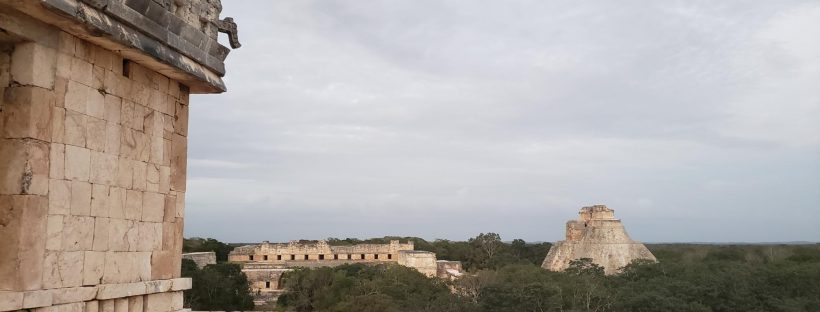
My wife and I zipped down to the Yucatan Peninsula last week for a friend’s wedding, down Thursday night, back Monday morning. Beautiful wedding, by the way. On Sunday our good friends Lidia Cepeda and Nacho Barroso arranged a very special tour to the ancient Mayan ruins of Uxmal on Sunday. The Director of Archeology of the site, José Huchim Herrera, Don Pepe as he is affectionately called by students and colleagues alike, honored us with a behind-the-scenes tour of the site.
Uxmal was a city of wonders, most of which have been restored under Huchim’s direct supervision. He is personally responsible for the exquisite restoration of the crown jewel of the site, The Palace of the Governor, considered the finest and most beautiful example of pre-Hispanic architecture ever discovered. Don Pepe explained the significance of the marvelous glyphs of the frieze that rings the building as thousands of bats whirled overhead at dusk. Magical!

But I have to admit that what impressed me most were the waterworks that made it possible for tens of thousands to thrive in the dry Puuc region where Uxmal is located, an environment with no rivers, no wells and no rain for nine months of the year.
We tend to think of rain harvesting as green vanity projects that don’t really make much of a difference, but in centuries past nothing could be further from the truth. Rain harvesting was the key to survival, and the Maya of the Puuc were masters of two distinct reservoirs very similar to the systems we employ today. The first was the chultun, a bottle-shaped underground reservoir carved into soft limestone, with plastered walls and a sloped apron around the small opening at the surface to capture water.

Archeologists have demonstrated that these household cisterns could typically support a small group of people year round with as little as 1.2 cubic meters per person, about 317 gallons per person. I was immediately reminded of our own Eco-Blox, which store 31.5 gallons. At ten blocks per person, a forty Eco-Blox reservoir would sustain a Mayan family of four even today! And with an innovative Clean Rain first flush diverter to collect clean water off a roof, today’s system might even reduce reservoir maintenance.
But Uxmal was a city of tens of thousands, without enough room for all the chultunob that would have been needed. How did the Maya live there with only three months of steady rains to depend on? Huchim discovered evidence of a sophisticated rain harvesting infrastructure just below the hilltop city. A natural depression was ringed with man-made berms and sealed with plaster to collect millions of gallons of rainwater during the short wet season, enough to sustain the city of 35000 people.
Again, we do exactly the same thing today. I pass the Meander Creek Reservoir near Youngstown Ohio when I drive in to the office. It was created in 1932 by building an earthen dam on the Mineral Ridge to impound the water of the Mahoning River. The Maya of Uxmal would have approved.
Click here for more information on rain harvesting to learn how you can add a rain harvesting system to your landscape!
About the Author:

DEMI FORTUNA
Demi has been in water garden construction since 1986. As Atlantic’s Director of Product Information, if he’s not building water features, he’s writing or talking about them. If you have a design or construction question, he’s the one to ask.



Great article Demi!! Now I got 1 more thing to visit on my Mexican “bucket list”!????????
Keep up the great blogs!